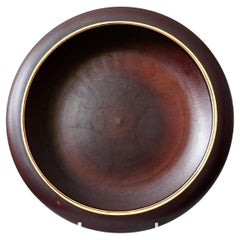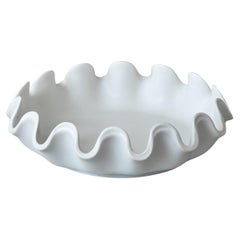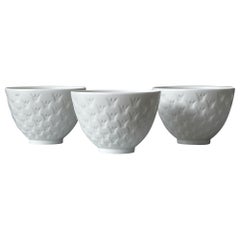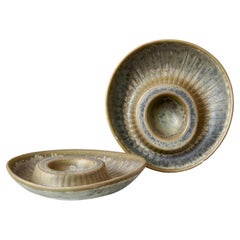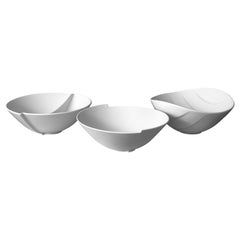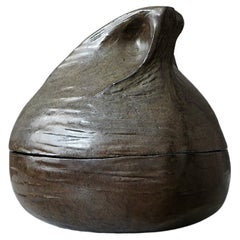Malmo - Bowls and Baskets
to
1
140
1
140
1
11
118
5
1
10
12
1
9
3
2
89
27
22
1
102
72
26
16
9
9,507
7,775
141
121
107
12
8
Height
to
Width
to
141
141
141
57
32
16
11
11
Item Ships From: Malmo
Art Deco Ceramic Bowl by Gunnar Nylund. Rorstrand, Sweden, 1930s. Brown Gold.
By Gunnar Nylund, Rörstrand, ALP Lidköping 1
Located in Malmö, SE
A beautiful ceramic art deco bowl. Amazing glaze with details in hand-painted gold.
Designed by Gunnar Nylund for Rörstrand, Sweden, 1930s.
Good condition. Some wear and scratches i...
Category
Mid-20th Century Swedish Art Deco Malmo - Bowls and Baskets
Materials
Ceramic
White 'Vaga' Bowl by Wilhelm Kage for Gustavsberg Studio, Sweden, 1940s
By Gustavsberg, Wilhelm Kage
Located in Malmö, SE
Beautiful 'Våga' bowl. Stoneware with white 'Carrara' glaze.
Made by Wilhelm Kåge at Gustavsberg Studio in Sweden, 1940s.
Swedish Grace.
Great condition. Some metal marks.
Impresse...
Category
Mid-20th Century Swedish Scandinavian Modern Malmo - Bowls and Baskets
Materials
Ceramic, Stoneware
Set of 3 Porcelain Crown Window Bowls by Gunnar Nylund. Rorstrand, Sweden, 1933.
By rorstrand studio, Rörstrand, Gunnar Nylund
Located in Malmö, SE
A set of three beautiful porcelain crown window bowls.
Designed by Gunnar Nylund for Rorstrand, Sweden, 1933.
Excellent condition. First sorting. Stamped 'Rörstrand' and 'Sweden'....
Category
Mid-20th Century Swedish Scandinavian Modern Malmo - Bowls and Baskets
Materials
Ceramic, Porcelain
Set of 2 Green Stoneware Bowls by Carl-Harry Stalhane, Rorstrand, Sweden, 1950s
By rorstrand studio, Rörstrand, Carl-Harry Stålhane
Located in Malmö, SE
A pair of rare and beautiful stoneware bowls with amazing glaze.
Made by Carl-Harry Stålhane at Rörstrand, Sweden, 1950s.
Excellent condition. Signed 'CHS' and makers mark 'R'.
Car...
Category
Mid-20th Century Swedish Mid-Century Modern Malmo - Bowls and Baskets
Materials
Ceramic, Stoneware
Full Set of White 'Surrea' Bowls by Wilhelm Kage for Gustavsberg, Sweden, 1940s
By Wilhelm Kage, Gustavsberg
Located in Malmö, SE
Three stunning 'Surrea' stoneware bowls with 'Carrara' glaze.
Made by Wilhelm Kåge at Gustavsberg Studio in Sweden, 1940s.
Excellent condition.
Stamped 'Gustavsberg'.
This is a ...
Category
Mid-20th Century Swedish Scandinavian Modern Malmo - Bowls and Baskets
Materials
Ceramic, Stoneware
Lidded Stoneware Bowl by Birger Astrom, Sweden, 1960s
By Hans Hedberg
Located in Malmö, SE
A beautiful lidded stoneware bowl.
Made by Birger Åström (1931-2020) in his studio in Örnsköldsvik, Sweden, 1960s.
Excellent condition. Signed 'BÅM'.
T...
Category
Mid-20th Century Swedish Mid-Century Modern Malmo - Bowls and Baskets
Materials
Ceramic, Stoneware
Faience Bowl by Stig Lindberg for Gustavsberg Studio, Sweden, 1950s
By Stig Lindberg, Gustavsberg
Located in Malmö, SE
A beautiful faience bowl with amazing geometric pattern.
Designed by Stig Lindberg in Gustavsberg Studio, Sweden, 1950s.
Good condition (there is a small mark in the glaze shown in ...
Category
Mid-20th Century Swedish Mid-Century Modern Malmo - Bowls and Baskets
Materials
Ceramic, Earthenware
Stoneware Leaf by Tyra Lundgren. Manufacture nationale de Sèvres, 1930s.
By Manufacture Nationale de Sèvres, Tyra Lundgren Carolina
Located in Malmö, SE
A beautiful stoneware bowl with amazing glaze.
Made by Tyra Lundgren. Executed during the artist's time spent at Sèvres, between 1934-1939.
Excellent condition.
Impressed with artist's name and maker's marks.
Tyra Lundgren (1897-1979) was one of the most multifaceted artists and modernists of the twentieth century. She was a painter, drawer, sculptor, ceramist, glass- and textile designer, as well as an author and an art critic. She was the first woman who designed glass for Paolo Venini at Murano in Venice and she also served as the artistic leader at Arabia in Helsinki at a time when men tended to hold those kinds of positions.
Tyra Lundgren grew up in Djursholm, near Stockholm. Her parents were John Petter Lundgren, professor at Veterinärinstitutet (institute of veterinary sciences) in Stockholm, and Edith Lundgren née Åberg, who was a housewife and raised their six children. The bourgeois home also comprised a nanny and a female cook. The family were very socially active, travelled often, and enjoyed the outdoor lifestyle. Tyra Lundgren’s schooling began at Djursholm coeducational school, where her teachers included Natanael and Elsa Beskow and Alice Tegnér. Her school friends included Greta Knutson-Tzara, Stellan Mörner, and Ingrid Rydbeck-Zuhr.
Tyra Lundgren knew from the time she was five years old that she wanted to be an artist. She first became aware of the profession through Axel Fahlcrantz, who rented a studio on the plot of land where she lived with her family. In 1913 she began to attend Högre konstindustriella skolan (HKS, now known as Konstfack, college of arts, crafts and design) where she studied decorative art as well as handicrafts in various forms until 1917. One of her fellow students and friends there was Estrid Ericson, who later founded Svenskt Tenn AB in 1924. Whilst attending HKS Tyra Lundgren also took painting lessons at the Althin school of painting. In 1917 she was accepted as a candidate at the Royal Swedish Academy of Fine Arts where, apart from breaks during which she undertook studies abroad, she remained until 1922. She spent a couple of months taking lessons from Anton Hanak in Vienna and from 1920–1923 she was a student of André Lhote in Paris.
Tyra Lundgren was primarily active in four countries: Sweden, Finland, France, and Italy. She spent much of her professional life travelling and considered herself to be a European. Greece and Mexico also formed important centres in her artistic life, as did the USA. She had an extensive social network which included focal individuals within twentieth century-European and American artistic and cultural circles.
Tyra Lundgren’s main artistic motifs were birds, fish, and people which she depicted through different techniques and materials. Her artistic expression involved a variety of different directions and styles. She was a pioneer of the 1920s Swedish Grace style, the name of which had been coined by the art critic Morton Shand at the Stockholm Exhibition of 1930. This was a Swedish Art Deco style, characterised by elegance and traditional art which contrasted with the current artistic ideals of functionalism.
Tyra Lundgren made her debut at a group exhibition held at Kungliga Akademien för de fria konsterna in 1921. She went on to show her work at various exhibitions throughout the 1920s. After that period she only very rarely exhibited her paintings.
Tyra Lundgren’s painted output can be divided into different periods or stylistic directions. The first of these, and the most extensive, was her post-Cubist period which began in 1920 on her arrival in Paris. Her paintings from this time and right up to the mid-1930s typically comprise portraits, self-portraits, live-model painting, still-lifes, interiors, and landscapes in the Cubist style. Many of the great number of self-portraits she painted were produced in the New Objective style, displaying broad variation in terms of clothes, poses and techniques. Two of these – Huvud med vit duk and Självporträtt both from 1921 – can be seen at Moderna Museet in Stockholm, although the majority of these works are at Gotlands Museum.
Tyra Lundgren’s second artistic period comprises the years of 1927 to 1929 and is characterised by the New Objective style inspired by medieval techniques and materials (Giotto, Piero della Francesca). Her motifs were still-lifes and landscapes. At this point she was living in Rome and was close to the circle involved in the Valori plastici: rivista d’arte art journal. This period saw a breakthrough in her development as a painter. From the 1950s through the 1970s her work can almost be described as belonging to the Concrete style. Using light pastel colours her paintings sought light in a sometimes non-figurative expression, but often depicting abstract bird-shapes or other nature-inspired imagery. Her paintings from this period are outsized and display powerful colours, in yellows, reds, and blues.
Tyra Lundgren maintained a constant production of drawings, both in terms of individual artworks and sketches for patterns and designs. She also produced the illustrations for her book Fagert i Fide. Årstiderna på en gammal gotlandsgård, published in 1961. During her early years she also produced advertising illustrations. She spent the final years of her life primarily working with lithographs which were printed at Galleri Prisma and depicted images of doves, swallows, magpies and crows.
Tyra Lundgren is meanwhile best known for her work as a ceramist and in this sphere she was one of Sweden’s leading exponents. She worked in the porcelain industry as a designer and as an artisan and ceramic sculptor. Her first job was at St Eriks Lervarufabrik in Uppsala from 1922–1924, she then worked at Arabia from 1924–1937, and at Rörstrand and Lidköping Porslinsfabrik. She was the artistic leader at Arabia ahead of the 1930 Stockholm Exhibition and she exhibited her work at the World’s Fairs. During the 1934–1938 period she was connected to the Manufacture nationale de Sèvres porcelain factory in Paris.
Tyra Lundgren was a pioneer when it came to giving ceramic art a public space in Sweden. She produced around 20 outsized reliefs in stoneware, so-called monumental reliefs. One of these is Märkeskvinnor, from 1947, for the former girls’ school at Bohusgatan in Stockholm. From the 1940s onwards Tyra Lundgren produced sculptural objects in Chamotte clay and stoneware, with various glazings. Her small birds are well-known and popular with many. When her ceramic efforts became too much for her during the 1970s she then produced models for sculptures in bronze. There are six of these in various places around the globe, including Solfågel in Almedalen, Visby.
Tyra Lundgren began to work as a glassware designer at Moser in Karlsbad in 1922 where she designed new table services and modernised older ones. She also worked freelance for Riihimäki factory in Finland during the 1924–1929 period. From 1934 to 1938 she was employed by Kosta glass factory where she mainly designed thick-walled bowls and vases, engraved with classical motifs. She was introduced to the glassmaker Paolo Venini at Murano during the Triennale di Milano of 1936 and they began a collaboration that lasted into the 1950s. As part of this collaboration Tyra Lundgren became the first woman to design glassware and, in conjunction with the glassblower Arturo Biasutto, she developed new techniques of glass production. Her motifs at this point were birds, fish, snail-shaped designs and leaf-patterned bowls using traditional techniques as well as in new designs. It was during this time that she created the so-called tissue-shaped bowls and it remains unclear as to who specifically came up with the design but Tyra Lundgren claimed it was of her making.
Tyra Lundgren was active as textile designer for Licium (now HV Licium), the sacred textiles...
Category
Mid-20th Century French Scandinavian Modern Malmo - Bowls and Baskets
Materials
Ceramic, Stoneware
Swedish Handmade Pine Bowl, Kinfolk Style, circa 1970
By Roland Wilhelmsson
Located in Albano Laziale, Rome/Lazio
A large handcrafted oval bowl made from pine in Sweden during the early 1970s. In very good condition. Excellent for serving bread or fruit out of for instance. Well represents the S...
Category
20th Century Swedish Organic Modern Malmo - Bowls and Baskets
Materials
Pine
$527 Sale Price
41% Off
Lidded Stoneware Bowl by Birger Astrom, Sweden, 1960s
By Hans Hedberg
Located in Malmö, SE
A beautiful lidded stoneware bowl with amazing glaze.
Made by Birger Åström (1931-2020) in his studio in Örnsköldsvik, Sweden, 1960s.
Excellent conditio...
Category
Mid-20th Century Swedish Mid-Century Modern Malmo - Bowls and Baskets
Materials
Ceramic, Stoneware
Stig Lindberg Ceramic Tray Model Pungo by Gustavsberg in Sweden
By Stig Lindberg
Located in Limhamn, Skåne län
Ceramic tray model Pungo designed by Stig Lindberg. Produced by Gustavsberg in Sweden.
Category
1950s Swedish Scandinavian Modern Vintage Malmo - Bowls and Baskets
Materials
Ceramic
Kaj Franck Bowls Produced by Nuutajärvi Notsjö in Finland
By Kaj Franck
Located in Limhamn, Skåne län
Rare set of 9 glass bowls designed by Kaj Franck. Produced by Nuutajärvi Notsjö in Finland.
Category
1950s Finnish Scandinavian Modern Vintage Malmo - Bowls and Baskets
Materials
Glass
Olof Ahlberg Dish in Pewter Produced by Schreuder & Olsson in Stockholm, Sweden
By Olof Ahlberg
Located in Limhamn, Skåne län
Large pewter dish designed by Olof Ahlberg. Produced by Schreuder & Olsson in Stockholm, Sweden.
Category
1970s Swedish Scandinavian Modern Vintage Malmo - Bowls and Baskets
Materials
Pewter
Ceramic Bowl by Gunnar Nylund, 1960's
By Gunnar Nylund
Located in Limhamn, Skåne län
Ceramic Bowl by Gunnar Nylund, 1960's
Additional Information:
Material: Ceramic
Style: Mid century, Scandinavian
Ceramic bowl model ARO
Produced by Rörstrand in Sweden
Dimensions (W...
Category
20th Century Swedish Scandinavian Modern Malmo - Bowls and Baskets
Materials
Ceramic
$1,437 / set
Johnny Mattsson Sculpture / Bowl Produced by Johnny Mattsson in Sweden
By Johnny Mattsson
Located in Limhamn, Skåne län
Sculpture / bowl designed by Johnny Mattsson. Produced by Johnny Mattsson in Sweden.
Category
1950s Swedish Scandinavian Modern Vintage Malmo - Bowls and Baskets
Materials
Pine
Bowl Produced in Sweden
Located in Limhamn, Skåne län
Large decorative bowl in teak by unknown designer. Produced in Sweden.
Category
1950s Swedish Scandinavian Modern Vintage Malmo - Bowls and Baskets
Materials
Teak
$2,396
Rare Ceramic Bowl / Tray by Carl-Harry Stålhane, 1950’s
By Carl-Harry Stålhane
Located in Limhamn, Skåne län
Rare Ceramic Bowl / Tray by Carl-Harry Stålhane, 1950’s
Additional Information:
Material: Ceramic
Style: Mid century, Scandinavian
Produced by Rörstrand in Sweden
Dimensions (W x D ...
Category
20th Century Swedish Scandinavian Modern Malmo - Bowls and Baskets
Materials
Ceramic
Decorative Bowl / Sculpture Produced in Sweden
Located in Limhamn, Skåne län
Decorative bowl / sculpture by unknown designer. Produced in Sweden.
Category
1950s Swedish Scandinavian Modern Vintage Malmo - Bowls and Baskets
Materials
Ash
Wooden Dish by Yngve Ekström, 1950s
By Yngve Ekström
Located in Limhamn, Skåne län
Wooden Dish by Yngve Ekström, 1950s
Additional Information:
Material: Wood
Style: Scandinavian, Mid century
Produced in Sweden
Dimensions: (W x D x H): 38...
Category
20th Century Swedish Scandinavian Modern Malmo - Bowls and Baskets
Materials
Wood
Johnny Mattsson Sculpture Bowl by Johnny Mattsson in Sweden
By Jonny Mattsson
Located in Limhamn, Skåne län
Rare large sculpture bowl designed by Johnny Mattsson. Produced by Johnny Mattsson in Sweden.
Category
1950s Swedish Scandinavian Modern Vintage Malmo - Bowls and Baskets
Materials
Pine
Ib Geertsen Bowl Produced in Denmark
By Ib Geertsen
Located in Limhamn, Skåne län
Enamel bowl designed by Ib Geertsen. Produced in Denmark.
Category
1950s Danish Scandinavian Modern Vintage Malmo - Bowls and Baskets
Materials
Enamel
Recently Viewed
View AllMore Ways To Browse
Ruth Milles
Desimone Hand Painted Art Pottery
Karin Bjorquist
Boda Finland
Italian Majolica Fruit Basket
Louis Vuitton Bowl
Murano Glass Blue Bowl Star
Robin Welch
Thumbprint Bowl
Tiffany Elsa Peretti Bowls
Virginia Metalcrafters Leaf
Wedgwood Lustre Dragon
Wood Tazza
18th C Spanish Ceramic
African Mortar And Pestle
Amber Candy Dish
Antique Italian Passata Bowl
Antique Tibetan Bowls
